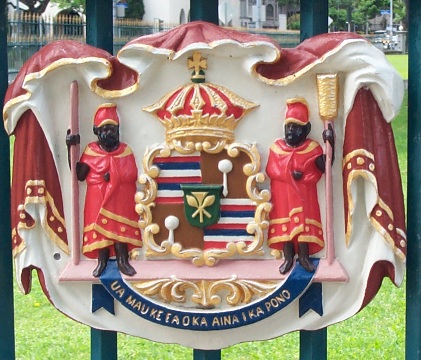And now it’s far later, and I find that my brain is rather fried and overloaded. But I’ll probably never get around to writing about today if I don’t do it now, so here’s what I can still remember at this moment.
Tim Berners-Lee’s keynote speech was unusual — he didn’t talk about the future of the Web. Instead, he talked about how “bits matter” and how the various specifications which make the Web possible all depend on other specifications, all the way down to the physical layer (at least). Tim also made a good argument for royalty-free standards for the Web — while not denying the usefulness of patents.
I chaired two sessions on “A Global Society?”, kicking off the Global Community track, where we are trying to explore how the technologies developed by the folks talking at the rest of the conference affect people around the world — both those who use the Web and those who don’t.
I was pleased at how many people took the trouble to find our track — we’re in the Sheraton Royal Hawaiian (most of the conference is in the Sheraton Waikiki, about 100 meters away), and at the far end of the hotel. Getting to us requires a concerted effort to ignore the wonderful weather and the beach. But the first session was standing-room only until they got us an extra 30 chairs, and the second session was also pretty full.
The first speaker was red keith bradley, who talked about Design Considerations for a Global Audience. Much of what he said was old news, but the message needs to be repeated until it’s heeded — you can’t assume that the person using your site is your clone. There are cultural issues (example: the Fed Ex site for the United Arab Emirates, which rotates through a number of pictures, including one of a picture of a woman in a short-sleeved Fed Ex uniform — not a likely sight there), language issues, bandwidth issues, cost issues, and many many more. Site designers need to consider why people are visiting the sites — in most cases, it’s probably not to admire the designer’s cleverness! A lively discussion followed.
Ashley Tucker then presented work done comparing Internet users in the UK and Egypt, especially when presented with VRML pages. He talked about reasons, other than the obvious economic ones, for lower Internet penetration in the Arab world. Discussion followed.
Libby Levison of MIT finished the session with a wonderful paper on enabling Internet search by e-mail for users in low-connectivity countries. By making the search asynchronous, you can greatly reduce the costs to the user — and do a better job of qualifying the results. This could be useful for “high-connectivity” users, too — imagine being able to submit a question, then go do something else (like watch a TV show or fly across the country), and then receive answers when you next fetch your e-mail. It could be almost as effective as asking a librarian! And again, a lively discussion followed, running on into lunchtime.
This year, the organizers have decided to omit sit-down lunches with speeches; instead, they’re setting up buffets and allowing people to mingle and talk during lunch. I’m not sure if this is for cost reasons (ah, for the glory days of 1999…or even 2001) or not, but I think it’s a great idea (though I hope we move on from sandwich makings for tomorrow’s lunch).
After lunch, it was back to the grind; one of our invited speakers didn’t take us up on the invitation, so we only had two talks in a 90-minute slot.
Linda Jackson followed up her talk last year with a report on Home Net Too, this time with some analysis of the data they gathered from the low-income families they provided with computers and Internet connectivity. There were some surprises — for example, there was hardly any use of the Internet for job training or seeking! They have lots more crunching to do, and I look forward to another report next year. Once more, there was plenty of discussion and debate.
Stu Weibel of the Dublin Core Metadata Initiative closed the session with a presentation on technology development as a conversation, and the need for standards and shared terminology. And, yet again, we had a lively discussion.
And there ended my hosting duties for this conference.
The final session of the day was hosted by my co-chair, but it didn’t help me take decent notes. And when I tried posting soon after the session, I had system problems, so this is a second attempt, almost a week later, with a fuzzy memory. *sigh*
The first speaker was Karima Boudaoud of the University of Geneva, who talked about Electronic Communication Issues related to Online Dispute Resolution Systems, an overview of the state of the art at using online techniques to assist in alternative dispute resolution systems (mediation, negotiation, and arbitration). She paid special attention to the needs of confidentiality and data integrity. One point of note — she didn’t know of any attempts to automate the actual dispute resolution process, just attempts to make it possible to handle most of the communications online instead of in-person.
Our second speaker, Manuel Oliveira of University College London, probably belonged in a different track. His paper, “Causing Mayhem on the Internet with Virtual Environments”, is a rather technical paper dealing with a Java-based system which can be used to build online distributed virtual environments (games!), and it’s worth reading. But he realized that presenting the details of such a system wouldn’t be terribly useful in the less-technical environment of the Global Community track, and so his presentation focussed on the social issues (such as the problem with trusting code on the client — believe it or not, people cheat!).
Finally, Dan Gillmor of the San Jose Mercury News gave an invited talk: “Will Hollywood Capture The Internet?”. He discussed the problems that the DMCA has caused and that the CBDPTA could cause — see his weblog for more.
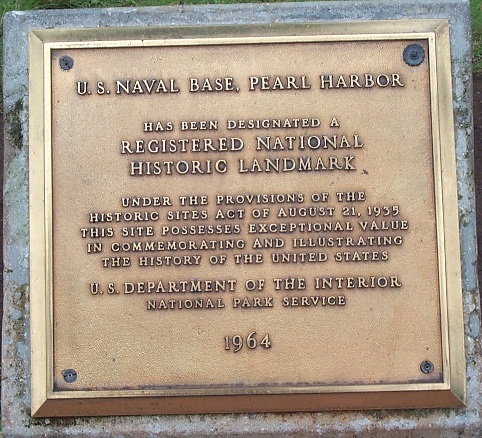 Besides the USS Arizona Memorial, the USS Missouri and the USS Bowfin are anchored nearby.
Besides the USS Arizona Memorial, the USS Missouri and the USS Bowfin are anchored nearby.  The
The 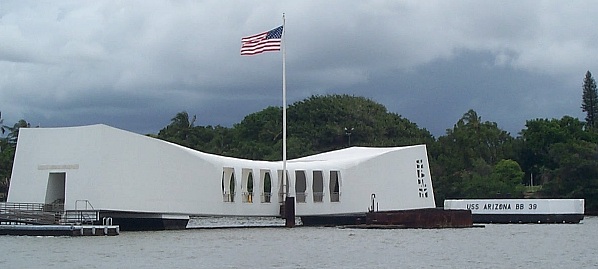 The memorial is built atop and at right angles to the wreckage of the Arizona; most of the Arizona is underwater, of course, but some parts do protrude from the water.
The memorial is built atop and at right angles to the wreckage of the Arizona; most of the Arizona is underwater, of course, but some parts do protrude from the water.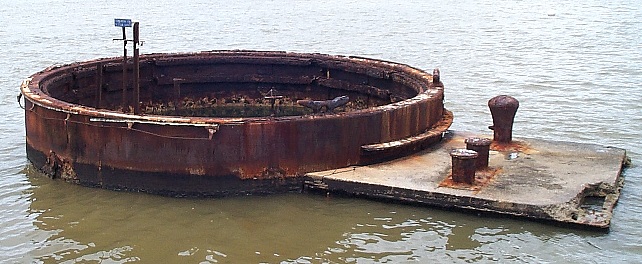 When the Arizona went down, she was carrying thousands of gallons of fuel oil; that oil has been slowly leaking out ever since 1941, and it is visible on the surface today.
When the Arizona went down, she was carrying thousands of gallons of fuel oil; that oil has been slowly leaking out ever since 1941, and it is visible on the surface today.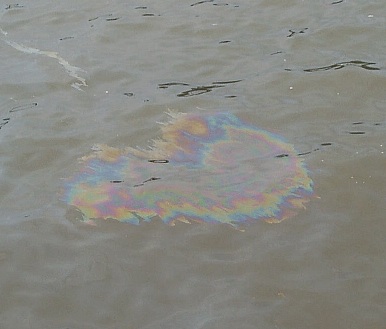 The government and environmentalists are worried, because the ship is deteriorating, and if the tanks should breach, there could be a major spill in Pearl Harbor. But any attempt to drain the oil is a sensitive topic, because 1177 men are still buried on the Arizona, and their families are concerned about disturbing their remains. One wall of the Memorial shows the names of all of the men who died on the Arizona.
The government and environmentalists are worried, because the ship is deteriorating, and if the tanks should breach, there could be a major spill in Pearl Harbor. But any attempt to drain the oil is a sensitive topic, because 1177 men are still buried on the Arizona, and their families are concerned about disturbing their remains. One wall of the Memorial shows the names of all of the men who died on the Arizona.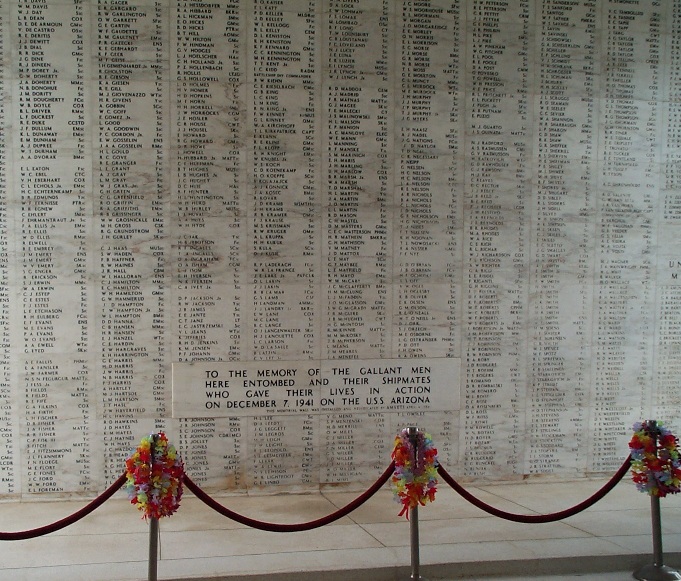 After a few minutes on the memorial, we boarded the boat and returned to shore, to await the return of our bus (and to give us a chance to visit the rest of the museum and the bookstore). I got photographic proof that I’d taken this trip (though the value of that proof isn’t what it was in the days before digital image manipulation) instead of staying in the background on all the shots.
After a few minutes on the memorial, we boarded the boat and returned to shore, to await the return of our bus (and to give us a chance to visit the rest of the museum and the bookstore). I got photographic proof that I’d taken this trip (though the value of that proof isn’t what it was in the days before digital image manipulation) instead of staying in the background on all the shots.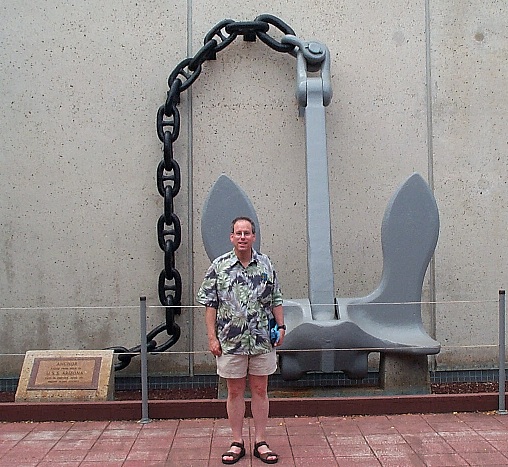 We then started back for Waikiki via
We then started back for Waikiki via  you can probably read the name of Ellison Onizuka, who was one of the Challenger astronauts.
you can probably read the name of Ellison Onizuka, who was one of the Challenger astronauts.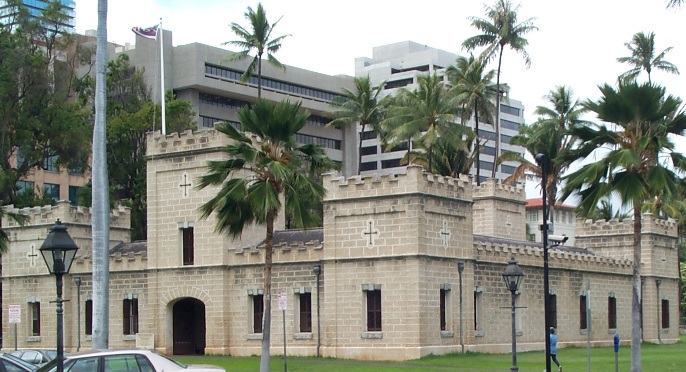 Then it was back to the conference for another bout of e-mail and some planning for tomorrow.
Then it was back to the conference for another bout of e-mail and some planning for tomorrow.